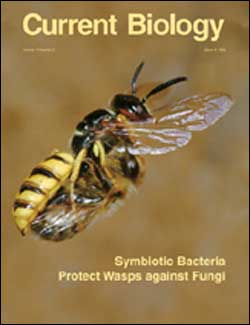Symbiotic bacteria protect hunting wasps from fungal infestation

Researchers have discovered a fascinating symbiotic relationship between a wasp species and a newly discovered bacterial species – a relationship that potentially sheds light on how bacteria can be successfully utilized by higher organisms in defensive mechanisms against other microbes. In the new work, researchers show that a solitary ground-nesting wasp, the European beewolf, harbors Streptomyces bacteria in unique structures within its antennae and that females utilize these bacterial symbionts to protect the wasp larvae against pathogenic fungi.
Detrimental microorganisms are a permanent threat to higher organisms, and because of their high reproductive potential and adaptability, they are extremely difficult to control. Ironically, the best counteragents against microbes are often other microbes that produce very potent antibiotics. Thus, an effective and elegant way to counter the threat caused by bacteria and fungi is to establish a symbiotic relationship with innocuous antibiotic-producing bacteria that provide protection against the most dangerous pathogens. As yet, only a few cases of defensive symbioses between higher organisms and bacteria have been reported.
In their new paper, Martin Kaltenpoth and his colleagues at the Biocenter of the University of Würzburg show that the European beewolf Philanthus triangulum has evolved a defensive symbiosis with a new species of bacteria of the genus Streptomyces. Interestingly, this genus comprises the most important group of bacteria for the production of antibiotics for human medicine.
Female beewolves provision their larvae with paralyzed honeybees in brood cells in the soil. As part of this process, the researchers show, they use their antennae to deliver the symbiotic bacteria to the ceiling of the brood cell before finally closing off the cell. The larvae then take up the bacteria and apply them to the silk threads of their cocoons. The researchers found that experimental removal of the bacteria caused increased fungal infestations and increased larval mortality – in fact, little larval survival – suggesting that the bacteria produce antibiotics that work against pathogenic fungi. These findings broaden our understanding of the evolution and functioning of symbioses that involve protective bacteria, and they may ultimately provide insight into strategies for dealing with antibiotic resistance in our own species’s efforts to combat harmful microbes.
Media Contact
All latest news from the category: Life Sciences and Chemistry
Articles and reports from the Life Sciences and chemistry area deal with applied and basic research into modern biology, chemistry and human medicine.
Valuable information can be found on a range of life sciences fields including bacteriology, biochemistry, bionics, bioinformatics, biophysics, biotechnology, genetics, geobotany, human biology, marine biology, microbiology, molecular biology, cellular biology, zoology, bioinorganic chemistry, microchemistry and environmental chemistry.
Newest articles

Bringing bio-inspired robots to life
Nebraska researcher Eric Markvicka gets NSF CAREER Award to pursue manufacture of novel materials for soft robotics and stretchable electronics. Engineers are increasingly eager to develop robots that mimic the…

Bella moths use poison to attract mates
Scientists are closer to finding out how. Pyrrolizidine alkaloids are as bitter and toxic as they are hard to pronounce. They’re produced by several different types of plants and are…

AI tool creates ‘synthetic’ images of cells
…for enhanced microscopy analysis. Observing individual cells through microscopes can reveal a range of important cell biological phenomena that frequently play a role in human diseases, but the process of…





















